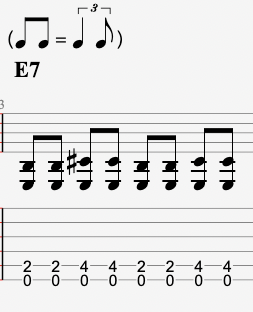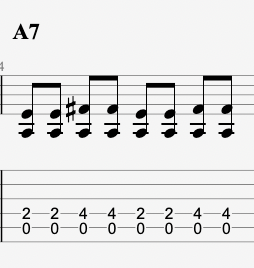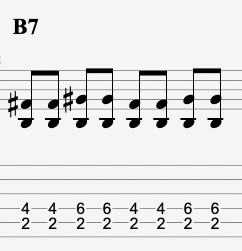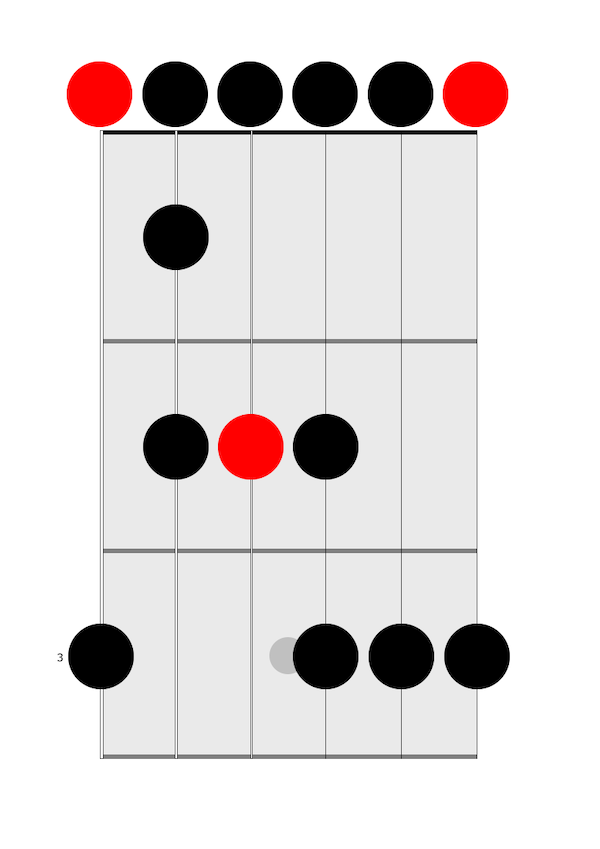Classic Blues Rhythm Guitar Lesson Step-By-Step
If you’re looking to improve your blues rhythm playing and spice up your jams…then this post will show you a fun and powerful way to do that.
Many musicians like to focus a lot on lead guitar. But they often overlook the fact that behind (almost) every great lead guitarist you’ll find an incredible rhythm player. Take for instance, Stevie Ray Vaughan whose iconic blues shuffle rhythms changed the game. Or Jimi Hendrix, who was a master at blending soulful R&B sounds behind his singing.
Or Tommy Emmanuel who started as the rhythm guy behind his brother in a family band.
While many musicians think the blues is boring or limited. This just shows a lack of depth in their knowledge of it.
So let’s get started with today’s blues rhythm guitar lesson.
For this example, we are going to be in the key of E. Let’s next take a look at the most common…
Blues Rhythm Guitar Chords
The three most common chords found in a blues progression in the key of E are E7, A7, and B7. These chords form the basis of the 12-bar blues structure, a fundamental and widely used format in blues music.
Here’s a detailed look at each chord and its role in the progression:
1. E7 (I7)
Notes: E, G#, B, D
Function: Tonic (I7)
Role: The E7 chord is the tonic chord in the key of E blues. It serves as the home base and is the starting and ending point of the 12-bar blues progression. The dominant seventh chord (E7) gives a bluesy sound, adding tension that seeks resolution.

2. A7 (IV7)
Notes: A, C#, E, G
Function: Subdominant (IV7)
Role: The A7 chord is the subdominant chord in the key of E blues. It typically appears in the fifth and sixth bars of the 12-bar blues progression, providing a sense of movement away from the tonic and setting up the return to the tonic.

3. B7 (V7)
Notes: B, D#, F#, A
Function: Dominant (V7)
Role: The B7 chord is the dominant chord in the key of E blues. It usually appears in the ninth and tenth bars of the 12-bar blues progression. The dominant seventh chord creates a strong sense of tension and anticipation, leading back to the tonic chord (E7) and completing the cycle.

In traditional Western music theory, chord progressions often follow a diatonic pattern. This means the chords are built from major and minor scales. But, the blues does not follow these rules. Notice the use of all dominant seventh chords throughout. These chords, such as E7, A7, and B7 in the key of E blues, incorporate a flattened 7th interval, creating a tense, bluesy sound. This defiance of conventional harmony adds richness and emotional depth to blues progressions, contributing to its unique and soulful expression.
These chords can then be morphed into what I call the “basic shuffle”. This is a pattern that moves from the root/fifth to the root/6th of the chord. Here’s what that could look like in place of the I chord:

This can also be applied to the IV chord like so:

And, finally the V chord too:

The main groove for a basic shuffle is an 8th-note “feel”. Counting 8th notes involves dividing each beat of a measure into two equal parts. In a 4/4 time signature, each measure has four beats, and each beat is divided into two 8th notes.
Count the beats as: "1, 2, 3, 4."
For 8th notes, add an "and" between each beat: "1 and 2 and 3 and 4 and." To internalize the rhythm, practice counting out loud.
"1 and 2 and 3 and 4 and."
Of course, these 8th notes are played with a swing feel.
From there, we can call upon the legendary blues master Jimmy Reed to add some spice to this blues guitar rhythm pattern.
Next, add a triplet on beat 4 using this pattern:

Just this subtle change can add a powerful movement to the rhythm.
From there you can blend in some lead lines using…
Blues Guitar Scales
The E minor blues scale is one of the most common scales found in blues music. It’s a six-note scale, and it’s not just used in blues. In fact, you’ll also hear it in rock, jazz, country, and many other genres. It is similar to the E minor pentatonic scale with the addition of one extra note, known as the "blue note." This blue note adds a characteristic bluesy flavor to the scale.
Practicing scales is a great way to help improve mobility and agility in your fingers. Just like an athlete trains to perform in a competition of game. You must train your fingers to perform on the fretboard.
Here’s an in-depth look at the E minor blues scale:
Notes of the E Minor Blues Scale
The E minor blues scale uses the following notes:
- E
- G
- A
- B♭
- B
- D
The formula for the minor blues scale, in terms of intervals from the root note, is:
- Root (1)
- Minor third (♭3)
- Perfect fourth (4)
- Diminished fifth (♭5) – "Blue note"
- Perfect fifth (5)
- Minor seventh (♭7)
Here is a common way to play the E minor blues scale on the guitar fretboard:

From there, you can take inspiration from legends like Stevie Ray Vaughan and Jimi Hendrix on how they used the E minor blues scale in their music.
For example, here is a blues lick you could drop into this rhythm guitar lesson. This is a great way to start combining lead lines with rhythm as well:

Let’s look at another example of a…
Powerful Blues Rhythm Guitar Lesson
This next example blends rhythm, single-note lines, and riffs together to make your groove sound like a full band.
It’s common for guitar players to get stuck in certain keys playing the blues. When you branch out and perform with other musicians in the real world. You’ll find the keys of B♭ and F to be very common blues guitar keys.
Especially in contexts involving horn sections and traditional blues structures. There are many reasons for this. Here are a few: B♭ is a common key for brass instruments like trumpets, trombones, and saxophones, which are often transposing instruments. For example, the B♭ trumpet plays a whole step higher than written, making B♭ a practical key for ensembles including brass.
Many classic blues songs and jazz standards are written in B♭, which has cemented its place in the repertoire of blues musicians. While B♭ may not be the first choice for beginners due to having to play bar chords. It’s important to know for more experienced players to add variety and richness to their playing.
Let’s take a look at three powerful blues rhythm chords you can use in the key of B♭.
These are Texas-inspired blues chords that have been used by countless blues legends to play rhythm.
Starting with…
Bb9 (I):
This chord has the notes Bb (root), D (3rd), F (5th), Ab (7th), C (9th).

This chord has a great sound. it puts the 3rd in the bass. You can technically call it a Bb9/D.
Eb9/C (IV):
This chord contains the notes Eb (root), G (3rd), Bb (5th), Db (7th), F (9th). (C in the bass indicates the chord is played over a C bass note).

And finally the…
F9/C (V):
This chord uses the notes F (root), A (3rd), C (5th), Eb (7th), G (9th). (C in the bass indicates the chord is played over a C bass note).

These chords can add sophistication to your blues rhythm guitar. All you have to do is take a typical 12-bar blues, but now add these chords in place of the I, IV, and V.
Typically, blues progressions use dominant 7th chords for the I, IV, and V. But these chord voicings extend the harmony to become (Bb9, Eb9/C, F9/C). These are dominant chords with the added complexity of 9th extensions. This adds a jazzy or bluesy flavor while still functioning within the same basic chord progression.
This groove is inspired by the great Texas blues musicians. But it takes on a more big band sound. This combined with single note lines, and a swinging shuffle rhythm can take your blues guitar playing to an entirely new level.
Conclusion:
To wrap it up, the possibilities become infinite once you have the core fundamentals of the blues down. Studying the blues masters is one of the best ways to get there fast. If you’d like to speed up your progress towards blues guitar success…Get your hands on my free blues scale pdf guide right here now:
Jon MacLennan
Like this blog post? Get Jon’s best guitar lessons straight to your inbox.
